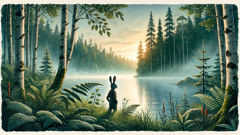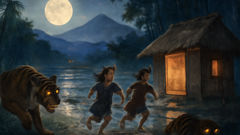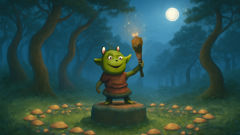Introduction
Long before the first canoe carved its way through the shining waters of the Great Lakes, before the pine forests sang with the songs of countless birds, the world was shrouded in mystery and shadow. The Anishinaabe people, living in harmony with the lakes, rivers, and endless woods of what we now call Canada, told stories at dusk around glowing fires, passing on memories older than the oldest cedar. Among all those tales, one name echoed above all others: Nanabozho—the shape-shifter, the trickster, the teacher, and the very heart of creation. Nanabozho is not easily described. He is at once a great rabbit and a man, a being born of sky and earth, always teetering between wisdom and mischief. His laughter could ripple across the surface of lakes, but his sorrow could call the rain. Where Nanabozho wandered, the world changed: rivers shifted their beds, animals learned new ways, and people listened for the secrets hidden in the wind. He is a spirit who bridges the wildness of nature with the curiosity and frailty of humanity. Through stories of Nanabozho, the Anishinaabe learned not only about how the world was made, but how to live within it—respecting its beauty, surviving its dangers, and finding humor even in hardship. This is the legend of Nanabozho: a tale braided from moonlit birch forests, thundering waterfalls, and the quiet wisdom of a culture rooted in the land. As you step into this story, listen for the rustle of his feet in the ferns, the sly wink in his voice, and the lessons tucked between his laughter and tears.
The First Dawn: Nanabozho’s Birth and the Shaping of the World
In the beginning, there was only water. The sky stretched on forever, and beneath it rolled a vast, endless sea, broken only by clouds and drifting birds. There were no mountains, no trees, no land for animals to roam. Yet in the heart of this watery world, the spirits dreamed of something more. The spirit of the West Wind, a force both gentle and fierce, yearned for a companion. She descended from the sky, rippling the surface of the endless water, and fell in love with the spirit of the Earth hidden below. From their union came Nanabozho, a being unlike any other: tall and lean, with quick eyes, nimble fingers, and ears long as willow leaves—a child of both sky and earth, forever shifting between the forms of man and rabbit.

As Nanabozho opened his eyes for the first time, dawn broke across the waters. The first sunlight danced on the ripples, and the world shimmered with possibility. Nanabozho gazed in wonder and laughter bubbled from his chest—he was alive, and there was so much to be done! His first steps sent ripples that rolled outward, drawing the attention of all the creatures that floated in the deep. Nanabozho listened closely to the songs of the birds, the whispers of the water, and the distant thunder that echoed above. The spirits watched, waiting to see what their new child would do.
Nanabozho wandered across the endless waters, sometimes hopping as a rabbit atop floating logs, sometimes walking upright as a man, always searching for something solid. He grew lonely, for there was no land to rest his feet and no trees to shade his head. He called out to the animals living beneath the surface—the muskrat, beaver, turtle, and otter. “I want to make a place to live,” he said. “Who among you can help me find earth?”
The animals were loyal to Nanabozho and eager to help. The loon dove first, slicing through the water, but returned empty-handed. The otter tried next, swift and graceful, but even she could not reach the bottom. The beaver dove with all his strength, but he, too, failed. It was the humble muskrat, smallest and least likely, who volunteered last. He took a deep breath and slipped beneath the waves. Long moments passed. The water stilled. Just as Nanabozho and the others began to fear for their friend, muskrat surfaced, exhausted but triumphant, clutching a tiny clump of wet earth in his paws.
Nanabozho beamed with gratitude and gently took the earth. Placing it on the back of turtle, he began to sing a song of creation. With each verse, the clump grew—spreading wider and wider until it became land. Trees burst from the soil, rivers found their courses, and grasses unfurled in the breeze. The animals cheered as mountains rose and lakes sparkled in the new sunlight. Turtle, patient and strong, became the foundation of this land—the place now known as Turtle Island.
Nanabozho wandered across this new world, his footprints shaping valleys and meadows. He taught the birds their songs and the wolves how to hunt. He coaxed wildflowers to bloom and painted the sky with wild colors. Where he laughed, berries grew sweet; where he wept, streams flowed clear. Yet Nanabozho was not only a creator—he was also a trickster. In his restless curiosity, he played pranks on the animals, often getting himself into trouble and learning valuable lessons about humility and respect. The world was new, but already it pulsed with the spirit of both order and mischief—thanks to Nanabozho’s unpredictable heart.
Lessons and Laughter: Nanabozho’s Adventures with Animals and Spirits
With Turtle Island stretching vast and green beneath the sky, Nanabozho’s spirit swelled with energy. There was so much to explore, so many creatures to meet—and so many chances for mischief. The world was fresh, its rules unwritten, and Nanabozho reveled in every discovery.
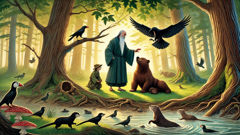
Early one morning, as dew glittered on wild strawberries, Nanabozho watched a group of crows bickering over a pile of corn. Their sharp voices echoed through the trees, so he decided to teach them a lesson. He crept close, shifting into a sleek black crow himself, and joined their squabble. “Why fight when there’s enough for all?” he cawed, but the crows ignored him. With a mischievous glint in his eye, Nanabozho cast a spell—suddenly, every ear of corn turned into wriggling worms! The crows squawked in horror and scattered, while Nanabozho fell over laughing. Later, he changed the worms back, but not before the lesson stuck: greed and squabbling often led to trouble.
Nanabozho’s adventures weren’t limited to pranks. He was also a wise teacher, showing animals how to live in harmony. One autumn day, he noticed Bear foraging hungrily, uncertain how to prepare for winter. Nanabozho led Bear through the forest, demonstrating how to find roots and berries, and how to make a warm den beneath the roots of an ancient pine. From that day on, Bear became a master of hibernation. Nanabozho also showed Beaver how to build strong lodges and Dipper how to dance along icy streams. Each lesson was laced with humor, but always carried wisdom about survival and respect.
The spirits of sky and earth watched Nanabozho’s antics with a mixture of pride and concern. Sometimes his tricks went too far, creating chaos. Once, he challenged Wind to a race across the lakes. As they flew, Nanabozho’s laughter whipped up such a storm that waves crashed into the forests and trees fell like matchsticks. Seeing the mess he’d made, Nanabozho felt shame—a feeling new to him. He spent days repairing the damage, replanting trees and calming frightened animals. Through this, he learned that power must be wielded with care and that laughter could heal as well as harm.
On clear nights, Nanabozho would sit by the fire with the animals, sharing stories and listening to their fears. He showed Otter how to slide on riverbanks and helped Deer find safe paths through the woods. Even his mistakes became teaching moments: when he stole fire from Thunderbird to warm the earth, his singed fur reminded everyone that boldness required caution. Gradually, Nanabozho’s playful chaos gave way to a deeper wisdom. He became not just a trickster, but a guide—a figure who helped the Anishinaabe people understand their own place within the delicate web of nature.
Sacrifice and Renewal: Nanabozho’s Grief, Transformation, and the Gift of Maple
As years turned, Turtle Island flourished under Nanabozho’s care. Forests thickened, rivers meandered bright and clear, and animals found their rhythms. But even in a world shaped by laughter, sorrow finds its place. Nanabozho, ever restless, grew curious about his own heart—the origins of loss, the need for healing, and the bittersweet lessons they bring.
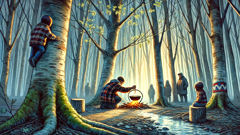
One spring, as ice melted from the lakes, Nanabozho’s closest companion—his grandmother Nokomis—fell ill. Nokomis had taught him songs that called berries from the earth and stories that tamed the wind. Her gentle hands soothed his wildest moods. When she passed into the spirit world, Nanabozho’s laughter vanished. He wandered through birch groves and rocky shores, his heart heavy with grief. Rain fell for days, echoing his tears, and for a time even the birds were silent.
In his sorrow, Nanabozho realized that all life is woven with loss and renewal. Wanting to honor Nokomis and help others face hardship, he sought a way to bring sweetness into the world. Deep in the forest, he found a stand of maples, their bare branches trembling in the late winter wind. Guided by memory and instinct, Nanabozho pierced the bark with a sharpened stone. To his surprise, clear sap flowed out—cool and pure as morning dew. He tasted it, then boiled it over a fire until it thickened into golden syrup. With each drop, his sadness lightened.
Nanabozho gathered the Anishinaabe people and showed them how to tap maples each spring. “This is a gift from the earth and from my grandmother,” he said. “It reminds us that even when we lose what we love, sweetness can return.” The people learned to gather sap with care, giving thanks to each tree and sharing syrup at feasts in honor of those who had passed. The maple became a symbol of resilience—proof that renewal follows every winter.
Through this sacrifice, Nanabozho grew wiser. He no longer ran from sorrow or hid behind tricks. He understood that every season held both joy and pain, each woven together like roots beneath the forest floor. His heart grew deeper, his laughter richer—a sound that carried across Turtle Island, comforting the living and honoring the spirits of those gone before.
Conclusion
Today, the legend of Nanabozho continues to ripple through the forests, lakes, and hearts of the Anishinaabe. His footprints can be found in every berry patch, every ripple on Turtle Island’s shores, and in every song sung around a campfire under the northern stars. He is a bridge between old and new, wildness and wisdom, laughter and loss. Through his playful spirit and open heart, Nanabozho teaches not only how the world began but how we can belong within it—cherishing its gifts, respecting its challenges, and seeking sweetness even after sorrow. His stories remind us that creation is ongoing, that we are all part of an ancient web of life that thrives on humor, humility, and hope. In every season’s change and every moment of discovery, Nanabozho’s legacy endures—inviting us to listen for his laughter on the wind, to see the world with curious eyes, and to walk gently upon the land that has always been, and will always be, home.

